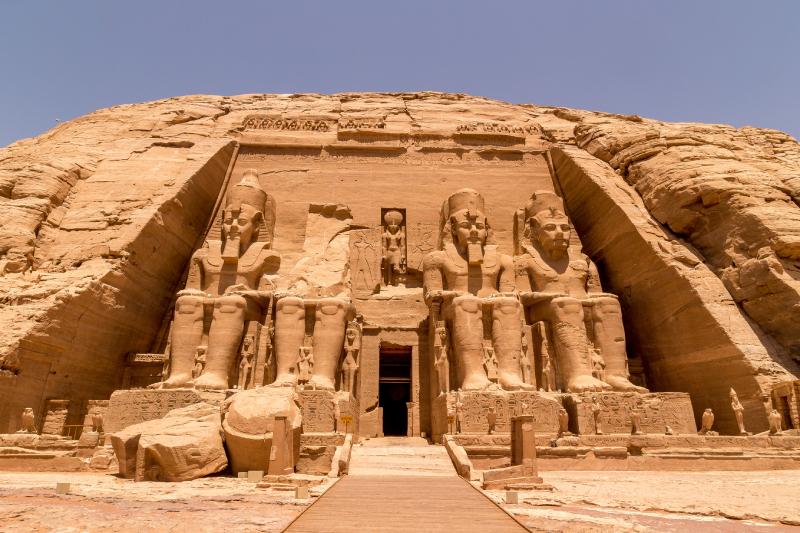
The Abu Simbel Temples stand as a testament to the grandeur of ancient Egyptian civilization. These awe-inspiring structures have captivated the imaginations of historians, archaeologists, and travelers alike. Carved into a mountainside, the temples honor the legacy of Pharaoh Ramses II and his queen, Nefertari, showcasing the artistic and architectural prowess of their era.
Nestled on the Nile’s banks, Abu Simbel was built to display the power and divinity of Pharaoh Ramses II. Its colossal statues and detailed carvings reflect a time when gods and kings ruled as one. The temples are a masterpiece of ancient Egyptian art and architecture, rich in history and cultural meaning. Today, Abu Simbel stands as a symbol of global heritage and preservation. Relocated to save it from flooding, it draws visitors worldwide who come to admire its grandeur and learn about the civilization that built this awe-inspiring monument.
Situated in the Nubian Desert, the Abu Simbel Temples are located in southern Egypt, near the border with Sudan. These monumental structures are part of the larger Nubian Monuments, a UNESCO World Heritage Site that stretches from Abu Simbel to Philae.
Located on the western bank of Lake Nasser, Abu Simbel’s temples were strategically placed to showcase Egypt’s power and spiritual significance. Built near the Aswan High Dam, their prominent position ensured visibility and impact. Despite the remote setting, Abu Simbel is accessible by air, road, or boat, offering a convenient yet adventurous journey. This iconic site remains a must-visit for history lovers seeking to explore the legacy of ancient Egyptian civilization.
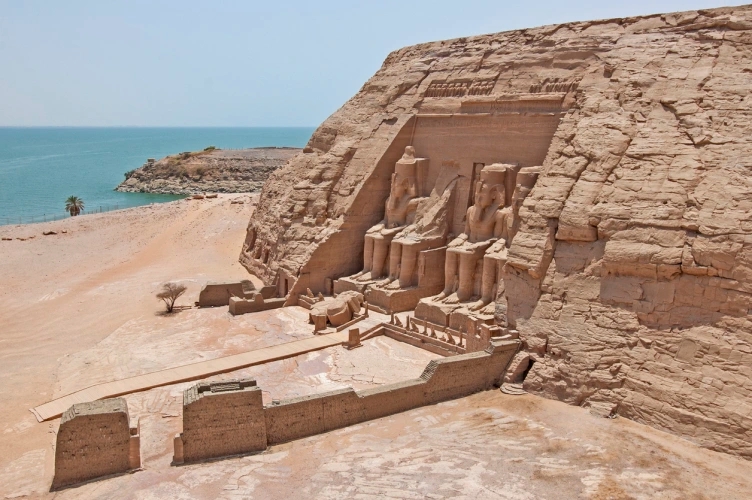
Commissioned during the reign of Pharaoh Ramses II in the 13th century BCE, the temples of Abu Simbel were constructed over a period of 20 years. This ambitious project was part of Ramses II's extensive building program, which aimed to immortalize his reign and celebrate his victories.
The temples were originally intended to intimidate Egypt's southern neighbors and reinforce the pharaoh's divine status. The larger temple is dedicated to the gods Amun, Ra-Horakhty, and Ptah, as well as the deified Ramses II himself. The smaller temple honors the goddess Hathor and Queen Nefertari, Ramses II's beloved wife.
Throughout history, the temples have faced numerous challenges, including natural disasters and human interventions. Despite these obstacles, they have remained largely intact, preserving their historical and cultural significance for future generations.

The architecture of the temples of Abu Simbel is a marvel of ancient engineering and artistry. The larger temple, known as the Great Temple, features four colossal statues of Ramses II seated on his throne, each standing 20 meters high. These statues guard the entrance and are designed to awe all who approach.
The Great Temple's interior features halls and chambers richly decorated with carvings and hieroglyphics, illustrating Ramses II’s military victories and religious rituals, offering deep insight into ancient Egyptian life. Nearby, the smaller temple dedicated to Queen Nefertari is equally stunning, with a facade of six statues, four of Ramses and two of Nefertari, highlighting his devotion. Inside, beautiful reliefs honor both the queen and the goddess Hathor, showcasing artistic and cultural brilliance.
In the 1960s, the construction of the Aswan High Dam posed a significant threat to the Abu Simbel Temples. The rising waters of Lake Nasser threatened to submerge the site, prompting an international rescue effort led by UNESCO. This ambitious project aimed to preserve the temples for future generations.
Over four years, the Abu Simbel temples were carefully dismantled and moved 65 meters higher to save them from flooding. Cut into over 2,000 blocks, each weighing up to 30 tons, they were reassembled with precision. This massive effort is hailed as one of the greatest feats in archaeological conservation. It preserved a vital cultural site and showcased the strength of international cooperation in protecting shared human heritage for future generations.
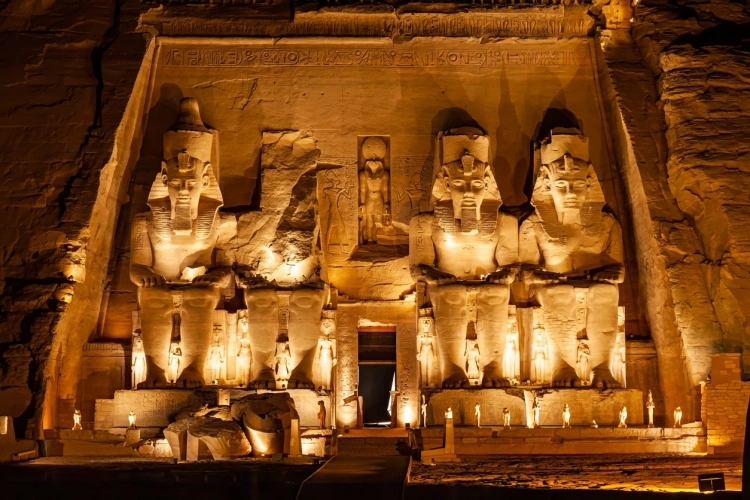
The temples of Abu Simbel are adorned with depictions of numerous key figures and deities from ancient Egyptian mythology. At the forefront is Pharaoh Ramses II, whose likeness is prominently featured in both temples, symbolizing his divine status and authority.
In the Great Temple, the gods Amun, Ra-Horakhty, and Ptah are honored alongside Ramses II. These deities were central to the ancient Egyptian pantheon and played a crucial role in the religious life of the period. Their presence underscores the temple's spiritual significance and the pharaoh's connection to the divine.
The smaller temple highlights the goddess Hathor, known for her roles as the goddess of love, beauty, and motherhood. Queen Nefertari is also prominently featured, emphasizing her importance in Ramses II's life and the reverence she commanded. These depictions offer a glimpse into the religious beliefs and societal values of ancient Egypt.
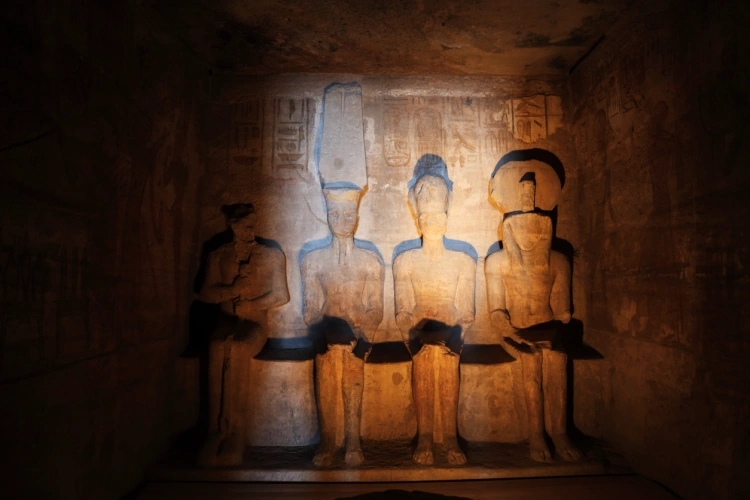
The Abu Simbel Temples held immense significance in ancient Egypt, serving as both religious centers and political statements. They were designed to demonstrate the power and divine nature of Pharaoh Ramses II, reinforcing his authority both domestically and internationally.
The temples played a key role in religious life, hosting ceremonies for the gods and the pharaoh. Their location along the Nile helped spread Egyptian culture and influence across the region. They also served as a lasting tribute to Ramses II’s reign, celebrating his legacy and ensuring his name would live on. Today, the temples continue to inspire visitors, offering a glimpse into the grandeur of ancient Egypt and the enduring power of its civilization.
Today, the temples of Abu Simbel stand as a testament to the ingenuity and vision of ancient Egyptian civilization. They continue to attract visitors from around the world, eager to experience their majesty and learn about the history and culture they represent.
In recent years, Abu Simbel has been upgraded with modern facilities and informative displays, making its rich history more accessible to visitors. These improvements enhance the experience while preserving the site's authenticity. The temples stand as a powerful symbol of successful heritage preservation, inspiring global efforts. Their relocation and upkeep highlight the importance of protecting cultural treasures for future generations to explore, learn from, and admire.
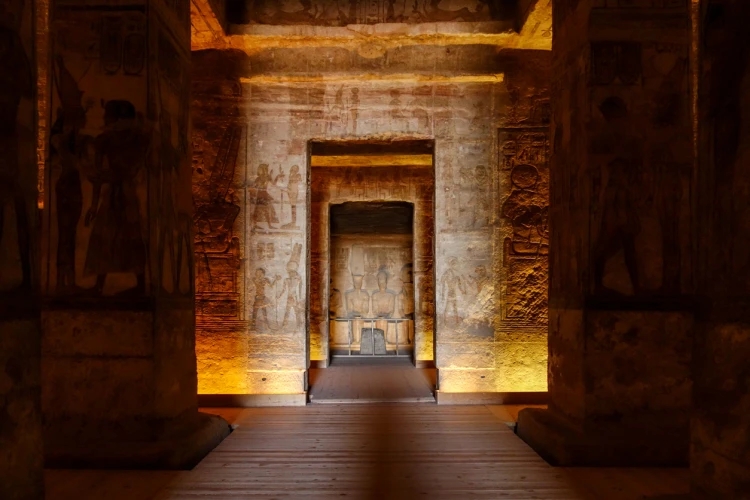
For those planning a visit to the Abu Simbel Temples, timing is an essential consideration. The region experiences extreme temperatures, with scorching summers and mild winters, making the cooler months the ideal time to explore the site. Many Egypt tours are scheduled during this season to ensure a more comfortable and enjoyable experience.
The best time to visit Abu Simbel is from October to April, when the weather is cooler and more pleasant. This allows for a more enjoyable experience of the temples and their surroundings. A highlight during this period is the Sun Festival, held in February and October, when sunlight aligns perfectly with the temple’s inner sanctum, illuminating the statues inside. This rare event showcases the architectural genius of ancient Egypt and draws visitors from around the world.
When planning a trip to the Abu Simbel Temples, a few travel tips can enhance the experience. First, consider booking a guided tour, as knowledgeable guides can provide valuable insights and historical context, enriching your visit.
Reaching Abu Simbel is possible via various means, including flights from Cairo or Aswan, bus tours, and even cruises on Lake Nasser. Each option offers a unique perspective on the journey, allowing travelers to choose the experience that best suits their preferences.
Once on-site, visitors should allocate ample time to explore both temples and the surrounding area. Comfortable footwear and sun protection are recommended, as the desert environment can be challenging. By preparing adequately, visitors can fully appreciate the splendor and history of this remarkable destination.
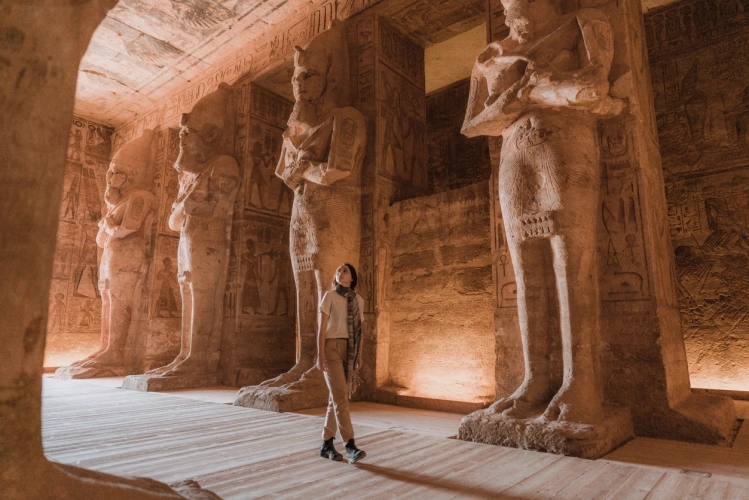
The Abu Simbel Temples offer an unparalleled glimpse into the majesty and complexity of ancient Egyptian civilization. From their rich history and architectural brilliance to their enduring cultural significance, these temples captivate all who visit.
Whether you're a history enthusiast, an architecture aficionado, or simply a curious traveler, Abu Simbel promises an unforgettable journey through time. As you plan your visit, consider joining Egypt tours to explore this remarkable site responsibly. Remember to respect and preserve its legacy, ensuring future generations can discover and cherish the wonders of Abu Simbel.
Q1. Where are the Abu Simbel Temples located?
The temples are located on the western bank of Lake Nasser in southern Egypt, near the border with Sudan.
Q2. Who built the Abu Simbel Temples?
They were built by Pharaoh Ramses II in the 13th century BCE to honor himself and his queen, Nefertari.
Q3. Why were the Abu Simbel Temples relocated?
The temples were relocated in the 1960s to save them from being submerged by the rising waters of Lake Nasser, caused by the construction of the Aswan High Dam.
Q4. How can I visit Abu Simbel Temples?
You can visit by flying from Aswan, taking a road trip, or cruising on Lake Nasser by boat.
Q5. When is the best time to visit Abu Simbel Temples?
The best time is between October and April when temperatures are milder. The Sun Festival in February and October is a unique time to witness sunlight illuminating the inner temple.
Q6. What is the Sun Festival at Abu Simbel Temples?
It’s a biannual event when the sun’s rays align perfectly with the temple’s inner sanctum, lighting up statues of Ramses II and gods inside the temple.
Q7. How long does it take to explore Abu Simbel Temples?
Typically, visitors spend 2 to 3 hours exploring both the Great Temple and the smaller Temple of Nefertari.
Q8. Why was the Abu Simbel Temples built?
The Abu Simbel Temples showcased his power, celebrated his victories, and honored the gods. The main temple was for Ramses and major deities, while the smaller one honored Queen Nefertari and Hathor, aiming to impress Egypt’s southern neighbors.
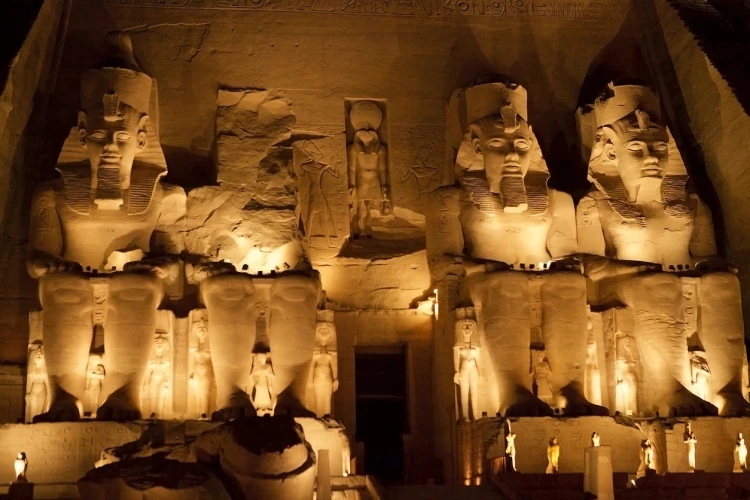

© Copyright 2025 Get Egypt Tour. All rights reserved.